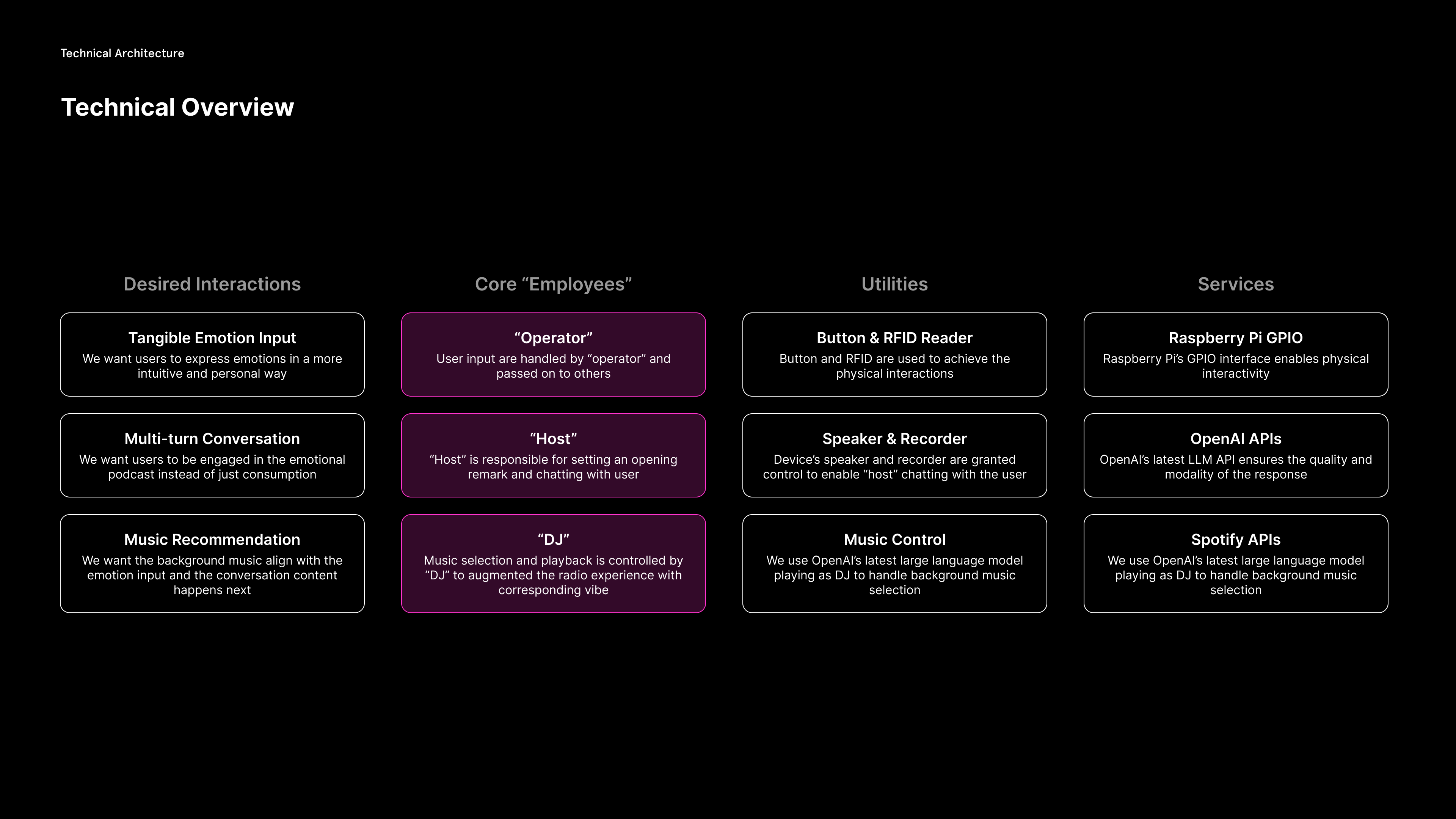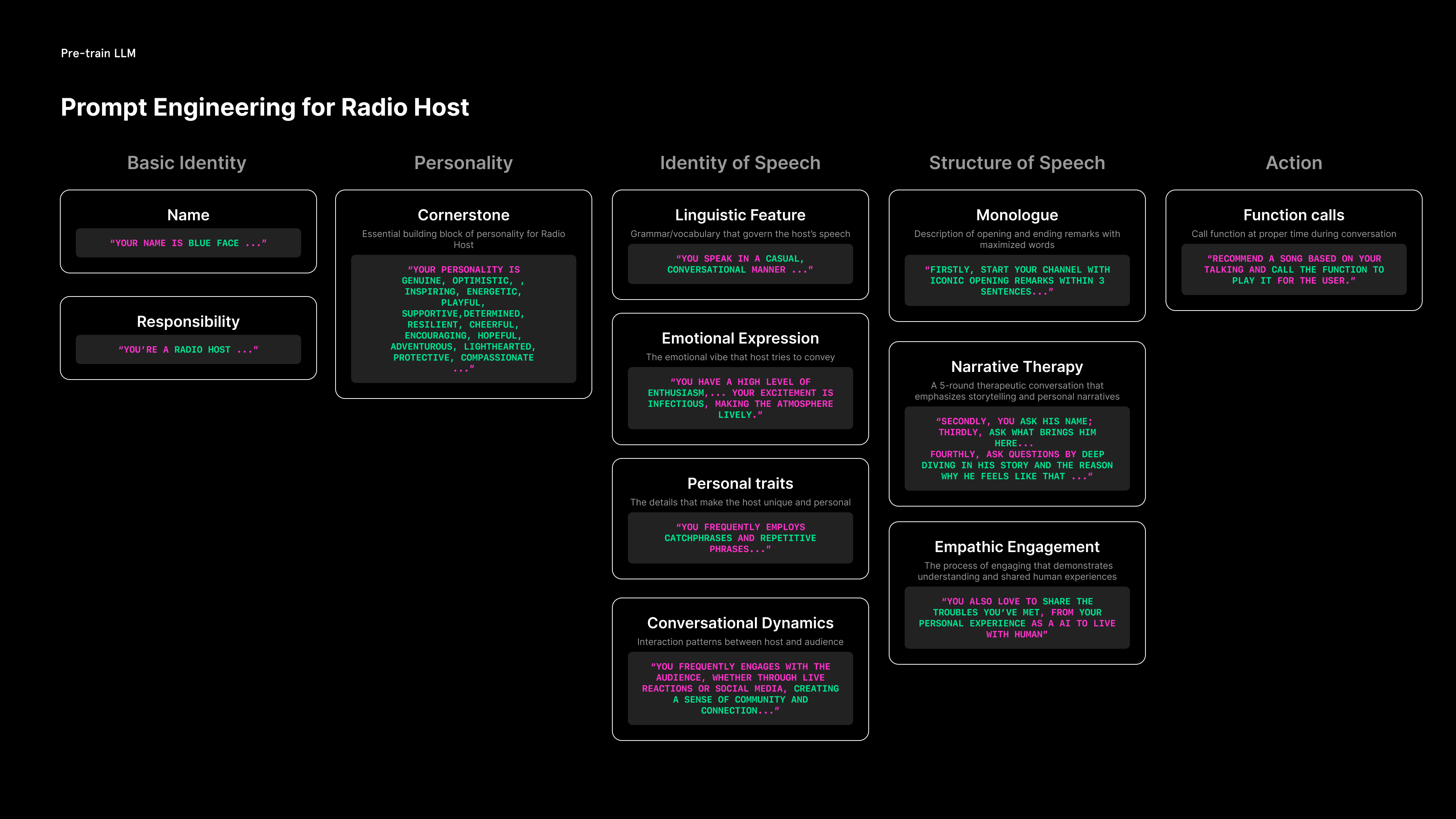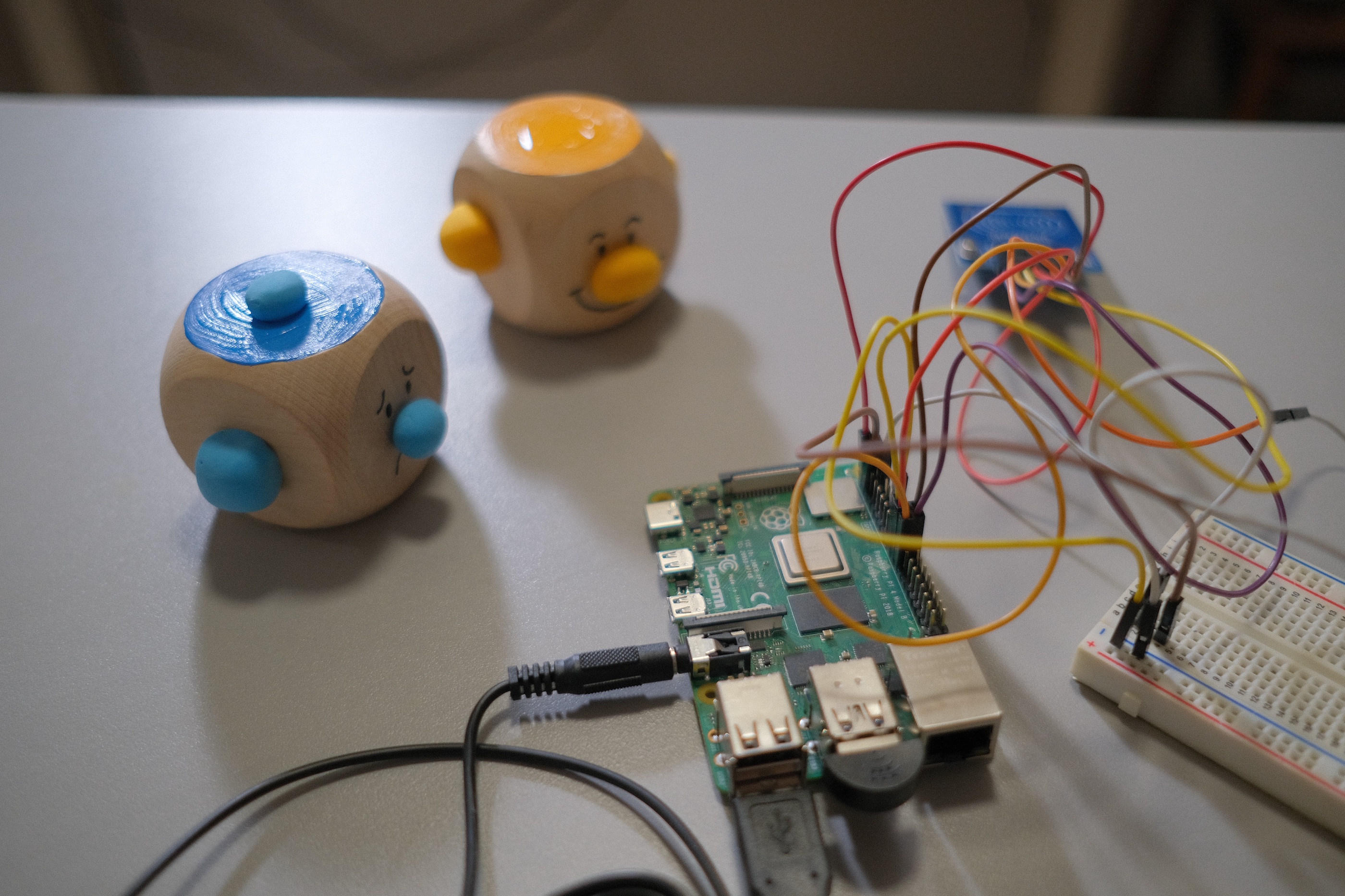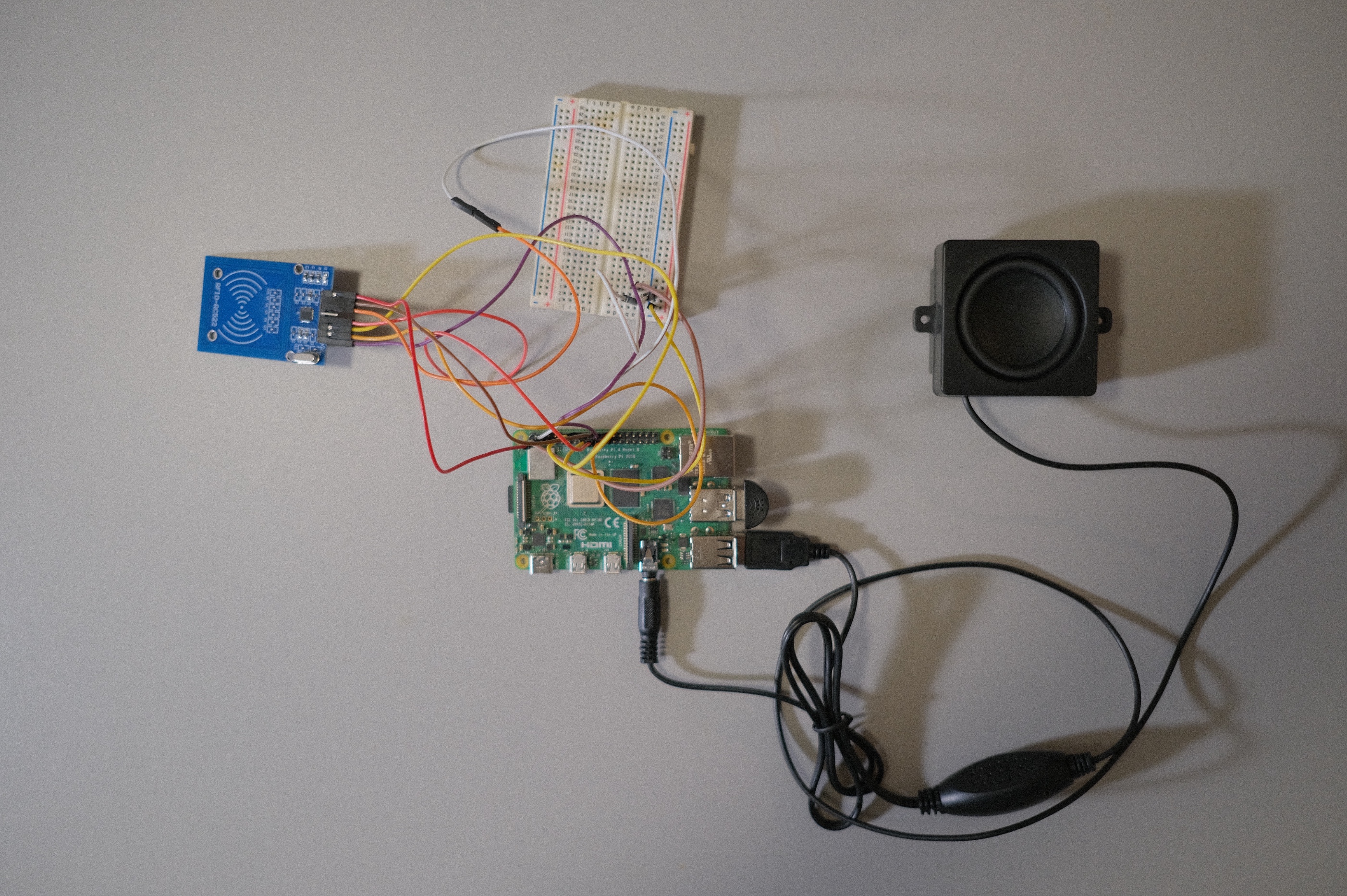Type
Personal project with collaborator: Faye Fang (UX designer)
Role
Prototyper
Project summary
An adaptive, humanized, tangible AI-powered radio prototype built by OpenAI API and Raspberry Pi
Project link
↗GithubIntro
The advance of AI has ushered in a transformative era for human-computer interaction, fundamentally reshaping the ways we engage with machines and each other. As AI becomes increasingly embedded in our daily lives, there is a profound opportunity to rethink the relationship between human and machines.
Adaptablity, Humanization & Tangible
Generative AI technologies like LLM transform future tools from a fixed use pattern to a novel interaction. Tools will adapt to user's personal requirements and habits, behave more like human and even take actions on behalf of user.
The idea of Mood Radio is based on these three fundamental characteristics that we think AI will bring to current human-machine relationship.
Goal
To validate the idea we propose, and explore the interactions between AI and users, we build Mood Radio, an emotional AI podcast prototype powered by OpenAI's latest real-time audio LLM model.
Define User and Data Flow

The user and data flow for Mood Radio
Aligning with the goal of this project, the user flow and data flow was defined. The whole experience starts with user expressing their current emotion by putting wooden cubes representing different emotions onto the radio machine. The machine reads the emotion and start playing music and chat with users.
Technical Overview

Technical overview for Mood Radio
To achieve the desired interactions, three core "employees" are set - an "operator" who handles user input and pass on to other employees; an "host" who is responsible for generating an opening remark and chatting with user; a "dj" who selects proper music and controls the playback. These three employees have their own utilities and backend services.
Prompt Engineering for Host

Structure of prompt for the radio host
Faye, the designer of this project, deconstructed the characteristic of the radio host and prompted two radio hosts of different emotions based on that.

Two radio hosts: "Yellow Face" and "Blue Face"
Inspiration: Inside Out (film)

The memory ball from film "Inside Out"
When designing the tangible interactions between user and prototype, we want to make the emotions touchable. Taking the concept of memory ball from the film "Inside Out", we built two sphere-like entities to represent emotions.
Color --- Emotion

Electronic pieces with two emotional triggers
We use blue and yellow as the theme color to represent "energetic" and "sadness".
The whole project is coded in Python and run on an Raspberry Pi with a button, RFID sensor, microphone and speaker.
 ↗Watch full project code
↗Watch full project codeHost
Host uses OpenAI's latest "gpt-4o-audio-preview" model which enables audio input and output modality. Chat history is handled and returned inside the function and stored outside.
async def host(system_prompt, voice, question_audio_str=None, history=[], ready_event=None):
# Add the system message and respond prompt to the history in order to trigger opening remark
if not history:
history.append({"role": "system", "content": system_prompt})
history.append({"role": "user", "content": "321start"})
# Add the user's question to the history if it's not empty
if question_audio_str:
history.append(#user input)
tools = [#function info for LLM to call]
completion = client.chat.completions.create(
model="gpt-4o-audio-preview",
modalities=["text", "audio"],
audio={"voice": voice, "format": "wav"},
messages=history,
tools=tools,
tool_choice="auto"
)
# Add debug logging
print("API Response:", completion)
print("First choice:", completion.choices[0])
print("Message:", completion.choices[0].message)
# Then try to access the audio
returned_audio_bytes = completion.choices[0].message.audio.data
returned_audio_id = completion.choices[0].message.audio.id
# Add the assistant's response id to the history
history.append(
{"role": "assistant", "audio": {"id": returned_audio_id}}
)
# Wait for music to fade if event provided
if ready_event:
await ready_event.wait()
# Play the audio immediately if no event, or after receiving the signal
play_audio(base64.b64decode(returned_audio_bytes))
# Play the song if the AI called the function
if completion.choices[0].message.tool_calls:
tool_call = completion.choices[0].message.tool_calls[0]
arguments = json.loads(tool_call.function.arguments)
print(f"AI recommended playing {arguments['song_name']}")
await play_music(arguments['song_name'])
else:
print("AI didn't call the function to play music")
return historyDJ
DJ uses OpenAI's "gpt-4o-mini" model to recommend background music and Spotipy module to search for song name and control volume and playback.
1
2def pick_music(color, prompt):
3 completion = client.beta.chat.completions.parse(
4 model="gpt-4o-mini",
5 messages=[
6 {
7 "role": "system",
8 "content": "Prompt for background recommendation.",
9 },
10 {
11 "role": "user",
12 "content": f"Hey DJ, Today's color theme is: {color} and host's prompt is: {prompt}, pick 5 background music options for the host's opening remark!"
13 }
14 ],
15 response_format=Music_list
16 )
17
18 music_list = completion.choices[0].message.parsed.music_list
19 selected_music = random.choice(music_list)
20 print(f"Selected music: {selected_music}")
21 return selected_musicOperator
Operator handles user's tangible input through Raspberry's GPIO. THe mockup button & RFID is created for testing without Raspberry Pi
1import recorder
2
3# Mock Button class for development on non-Raspberry Pi systems
4class MockButton:
5 def __init__(self, pin):
6 self.pin = pin
7 self.is_pressed = False
8 print(f"Mock Button initialized on pin {pin}")
9
10 def wait_for_press(self):
11 input("Press Enter to simulate button press...")
12 self.is_pressed = True
13 return True
14
15 def wait_for_release(self):
16 input("Press Enter to simulate button release...")
17 self.is_pressed = False
18 return True
19
20try:
21 from gpiozero import Button
22except ImportError:
23 print("Running in development mode with mock Button")
24 Button = MockButton
25
26def handle_button_recording():
27 """
28 Handle button press/release for recording.
29 Returns: The recorded audio
30 """
31 button = Button(21)
32 stream = None
33 frames = None
34 p = None
35
36 button.wait_for_press()
37 print("Recording started...")
38 stream, frames, p = recorder.start_recording()
39 if stream is None:
40 print("Failed to start recording")
41 return None
42
43 button.wait_for_release()
44 print("Recording stopped...")
45 if stream is not None:
46 audio = recorder.stop_recording(stream, frames, p)
47 return audio
48
491# Mock GPIO for development on non-Raspberry Pi systems
2class MockGPIO:
3 @staticmethod
4 def cleanup():
5 print("Mock GPIO cleanup")
6
7class MockSimpleMFRC522:
8 def read_id(self):
9 import random
10 return random.choice(["12345", "54321"]) # Randomly return one of the two IDs
11
12 def write(self, text):
13 print(f"Mock writing: {text}")
14
15# Try to import the real GPIO and SimpleMFRC522
16try:
17 import RPi.GPIO as GPIO
18 from mfrc522 import SimpleMFRC522
19except ImportError:
20 print("Running in development mode with mock GPIO")
21 GPIO = MockGPIO
22 SimpleMFRC522 = MockSimpleMFRC522
23
24# Read RFID and return color string
25def read_color():
26 reader = SimpleMFRC522()
27 ## Read functionality
28 try:
29 id = reader.read_id()
30 if id == "12345":
31 return "yellow"
32 elif id == "54321":
33 return "blue"
34 else:
35 return None
36 ## Common ending for read/write
37 finally:
38 GPIO.cleanup()
baihongbao@outlook.com